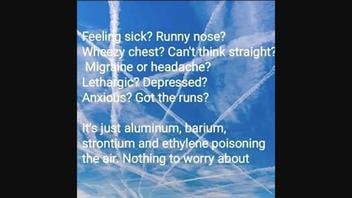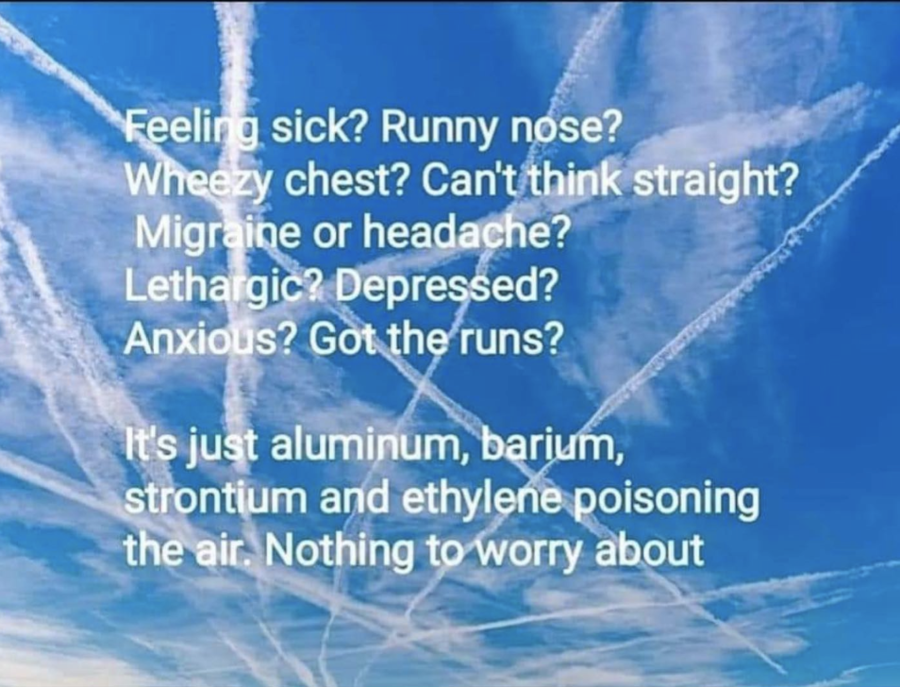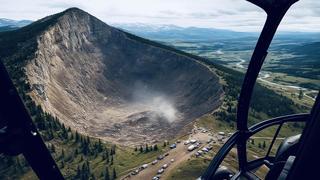
Do "chemtrails" contain the chemicals aluminum, barium, strontium and ethylene to cause a number of negative health impacts, including migraines, runny noses, depression, lethargy and anxiety? No, that's not true: Experts largely agree that "chemtrails" are a conspiracy theory not proven by science. Contrails, white lines of condensation released by aircraft primarily made of water vapor, are commonly confused for supposed "chemtrails." Contrails are not known to pose a risk to human health, according to several federal agencies. An expert in atmospheric chemistry told Lead Stories that "chemtrails" do not exist.
The claim originated in a post on Instagram on May 24, 2023, that suggested chemicals contained in chemtrails cause a number of negative health impacts. A caption with the post read:
🚨No caption needed...
#chemtrails
#geoengineering
#poisonskies
#skybastards
#corruptgovernment
#blockingthesun
#evil
#crimesagainsthumanity
#pennsylvaniaskies
Below is how the post appeared at the time of writing:
(Source: Instagram screenshot taken Mon June 12 16:22:44 UTC 2023)
Text laid over a picture of blue sky crisscrossed by several aircraft contrails said:
Feeling sick? Runny nose?
Wheezy chest? Can't think straight?
Migraine or headache?
Lethargic? Depressed?
Anxious? Got the runs?
It's just aluminum, barium,
strontium and ethylene poisoning
the air. Nothing to worry about
Atmospheric experts largely agree that "chemtrails" are a conspiracy theory not proven by scientists. What is often confused for chemtrails are contrails, or long trails of condensation (water vapor) released in aircraft engine exhaust. The duration and size of contrails are impacted by atmospheric conditions like temperature and humidity, according to the Royal Aeronautical Society.
Contrails pose no known risk to human health
Lead Stories spoke with Professor Andrew Dessler, an expert in atmospheric chemistry and director of the Texas Center for Climate Studies at Texas A&M University. In an email to Lead Stories received June 12, 2023, Dessler explained the differences between contrails and chemtrails:
Contrails are condensation trails produced by the exhaust of aircraft engines. As jet fuel burns, it releases water vapor which, upon contact with the cold upper-atmosphere air, condenses into ice crystals, leaving behind visible trails.
'Chemtrails,' on the other hand, are part of a conspiracy theory suggesting that the trails left by aircraft are chemical or biological agents deliberately sprayed for harmful or undisclosed purposes.
Contrails do not reach the Earth's surface because they fall slowly and eventually evaporate. Additionally, contrails are not known to contain any of the ingredients listed in the post on Instagram.
"Contrails are composed primarily of water in the form of ice crystals but also contain aircraft engine emissions such as sulfur compounds and soot particles. Aluminum, barium, strontium, and ethylene are not typical components of jet fuel so they would not be in contrails," Dessler explained.
Because contrails are predominantly water and chemtrails are not proven to exist, Dessler added that "the symptoms in the Instagram post are likely not related to either."
An interagency report published in 2000 by the U.S. Environmental Protection Agency (EPA), the Federal Aviation Administration, the National Oceanic and Atmospheric Administration and NASA similarly found that "persistent contrails pose no direct threat to public health."
There is no scientific evidence that chemtrails exist
The chemtrail hoax has been around since at least 1966. It falsely "accuses the Air Force of being involved in spraying the US population with mysterious substances and show[s] various Air Force aircraft 'releasing sprays' or generating unusual contrail patterns," the EPA wrote in a 2014 report.
However, there is no scientific basis for the chemtrail conspiracy theory.
For example, a 2016 study out of Carnegie Science at the University of California, Irvine surveyed leading atmospheric scientists around the world. Publishing in the peer-reviewed journal Environmental Research Letters, study authors found that participating experts had not encountered evidence of a "secret spraying program" in their work and agreed that such "alleged evidence ... could be explained through other factors, such as typical airplane contrail formation and poor data sampling." As air travel continues to expand, the study authors also noted contrail sightings are expected to increase globally.
The EPA reports that Air Force-operated aircraft contrails may sometimes contain other components, like those from exhaust gases, deployed flares, pest or weed control spraying, or in-flight emergency fuel releases. Each of these, the agency adds, "usually have very minor environmental impact over a very limited geographical area."
That same report wrote that "aerial spraying for pest or weed control and fire suppression is the only Air Force activities which involve aircraft intentionally spraying chemical compounds (insecticides, herbicides, fire retardants, oil dispersants)."
Lead Stories has fact checked other false claims involving chemtrails, including that it is not an Air Force policy to "control the weather by 2025," that websites about geoengineering do not prove airplanes are spraying the atmosphere to control the weather and that an edited photo did not provide evidence of authentic "team chemtrail."















